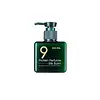What's inside
What's inside
 Key Ingredients
Key Ingredients

No key ingredients
 Benefits
Benefits

 Concerns
Concerns

 Ingredients Side-by-side
Ingredients Side-by-side

Water
Skin ConditioningDimethicone
EmollientPropylene Glycol
HumectantCyclopentasiloxane
EmollientCetearyl Alcohol
EmollientButylene Glycol
HumectantGlyceryl Stearate
EmollientPolysorbate 80
EmulsifyingBehentrimonium Chloride
PreservativeParfum
MaskingIsopropyl Alcohol
SolventMacadamia Ternifolia Seed Oil
EmollientPhytantriol
HumectantSimmondsia Chinensis Seed Oil
EmollientCyclotetrasiloxane
EmollientHydrolyzed Silk
HumectantHydrolyzed Cottonseed Protein
Skin ConditioningSynthetic Fluorphlogopite
Titanium Dioxide
Cosmetic ColorantFibroin
Hydrolyzed Collagen
EmollientPhenoxyethanol
Preservative1,2-Hexanediol
Skin ConditioningGelatin
Hydrogenated Lecithin
EmulsifyingHydrolyzed Keratin
HumectantAvena Sativa Kernel Extract
AbrasiveHydrolyzed Corn Protein
Skin ConditioningHydrolyzed Soy Protein
HumectantHydrolyzed Wheat Protein
Skin ConditioningSodium Hyaluronate
HumectantAcorus Calamus Root Extract
PerfumingAdansonia Digitata Seed Extract
Skin ConditioningAloe Barbadensis Leaf Extract
EmollientCamellia Japonica Flower Extract
EmollientEuterpe Oleracea Fruit Extract
Laminaria Japonica Extract
Skin ProtectingMalpighia Emarginata Fruit Extract
Skin ConditioningMoringa Oleifera Seed Extract
Skin ConditioningNelumbo Nucifera Extract
Skin ConditioningPropolis Extract
Skin ConditioningPrunus Avium Fruit Extract
Skin ConditioningPrunus Persica Fruit Extract
AbrasivePrunus Serrulata Flower Extract
Skin ConditioningMalus Domestica Fruit Extract
AntioxidantSalvia Officinalis Extract
AntimicrobialViola Mandshurica Flower Extract
AntioxidantTin Oxide
AbrasiveAcetic Acid
BufferingEthylhexylglycerin
Skin ConditioningAcetyl Hexapeptide-8
HumectantWater, Dimethicone, Propylene Glycol, Cyclopentasiloxane, Cetearyl Alcohol, Butylene Glycol, Glyceryl Stearate, Polysorbate 80, Behentrimonium Chloride, Parfum, Isopropyl Alcohol, Macadamia Ternifolia Seed Oil, Phytantriol, Simmondsia Chinensis Seed Oil, Cyclotetrasiloxane, Hydrolyzed Silk, Hydrolyzed Cottonseed Protein, Synthetic Fluorphlogopite, Titanium Dioxide, Fibroin, Hydrolyzed Collagen, Phenoxyethanol, 1,2-Hexanediol, Gelatin, Hydrogenated Lecithin, Hydrolyzed Keratin, Avena Sativa Kernel Extract, Hydrolyzed Corn Protein, Hydrolyzed Soy Protein, Hydrolyzed Wheat Protein, Sodium Hyaluronate, Acorus Calamus Root Extract, Adansonia Digitata Seed Extract, Aloe Barbadensis Leaf Extract, Camellia Japonica Flower Extract, Euterpe Oleracea Fruit Extract, Laminaria Japonica Extract, Malpighia Emarginata Fruit Extract, Moringa Oleifera Seed Extract, Nelumbo Nucifera Extract, Propolis Extract, Prunus Avium Fruit Extract, Prunus Persica Fruit Extract, Prunus Serrulata Flower Extract, Malus Domestica Fruit Extract, Salvia Officinalis Extract, Viola Mandshurica Flower Extract, Tin Oxide, Acetic Acid, Ethylhexylglycerin, Acetyl Hexapeptide-8
C13-14 Isoparaffin
EmollientIsododecane
EmollientDimethiconol
EmollientC12-15 Alkyl Benzoate
AntimicrobialHydrolyzed Silk
HumectantHydrolyzed Wheat Protein
Skin ConditioningHydrolyzed Corn Protein
Skin ConditioningHydrolyzed Soy Protein
HumectantPhenoxyethanol
PreservativeWater
Skin ConditioningParfum
MaskingBenzyl Benzoate
AntimicrobialCitronellol
PerfumingCoumarin
PerfumingGeraniol
PerfumingHexyl Cinnamal
PerfumingLinalool
PerfumingIngredients Explained
These ingredients are found in both products.
Ingredients higher up in an ingredient list are typically present in a larger amount.
We don't have a description for Hydrolyzed Corn Protein yet.
You can find hydrolyzed silk in both haircare and skincare products. According to a manufacturer, it can help improve skin and hair hydration.
This ingredient is created by adding acid or enzymes to 'hydrolyze' silk protein.
Due to the origins of this ingredient, it is not vegan. Silk is an animal product from silkworms.
Depending on the source, this ingredient can be considered cruelty-free. It is created from left-over cocoons of silkworms. We recommend reaching out to the brand if you have questions about where their hydrolyzed silk comes from.
Learn more about Hydrolyzed SilkHydrolyzed Soy Protein is a vegan protein made to mimic hydrolyzed collagen. It is created from soy, or glycine soja.
This ingredient is a humectant, meaning it helps hydrate the skin by binding to water. According to a manufacturer, it is also a great hair conditioner.
Read more about hydrolyzed collagen here.
Learn more about Hydrolyzed Soy ProteinWe don't have a description for Hydrolyzed Wheat Protein yet.
Parfum is a catch-all term for an ingredient or more that is used to give a scent to products.
Also called "fragrance", this ingredient can be a blend of hundreds of chemicals or plant oils. This means every product with "fragrance" or "parfum" in the ingredients list is a different mixture.
For instance, Habanolide is a proprietary trade name for a specific aroma chemical. When used as a fragrance ingredient in cosmetics, most aroma chemicals fall under the broad labeling category of “FRAGRANCE” or “PARFUM” according to EU and US regulations.
The term 'parfum' or 'fragrance' is not regulated in many countries. In many cases, it is up to the brand to define this term.
For instance, many brands choose to label themselves as "fragrance-free" because they are not using synthetic fragrances. However, their products may still contain ingredients such as essential oils that are considered a fragrance by INCI standards.
One example is Calendula flower extract. Calendula is an essential oil that still imparts a scent or 'fragrance'.
Depending on the blend, the ingredients in the mixture can cause allergies and sensitivities on the skin. Some ingredients that are known EU allergens include linalool and citronellol.
Parfum can also be used to mask or cover an unpleasant scent.
The bottom line is: not all fragrances/parfum/ingredients are created equally. If you are worried about fragrances, we recommend taking a closer look at an ingredient. And of course, we always recommend speaking with a professional.
Learn more about ParfumPhenoxyethanol is a preservative that has germicide, antimicrobial, and aromatic properties. Studies show that phenoxyethanol can prevent microbial growth. By itself, it has a scent that is similar to that of a rose.
It's often used in formulations along with Caprylyl Glycol to preserve the shelf life of products.
Water. It's the most common cosmetic ingredient of all. You'll usually see it at the top of ingredient lists, meaning that it makes up the largest part of the product.
So why is it so popular? Water most often acts as a solvent - this means that it helps dissolve other ingredients into the formulation.
You'll also recognize water as that liquid we all need to stay alive. If you see this, drink a glass of water. Stay hydrated!
Learn more about Water